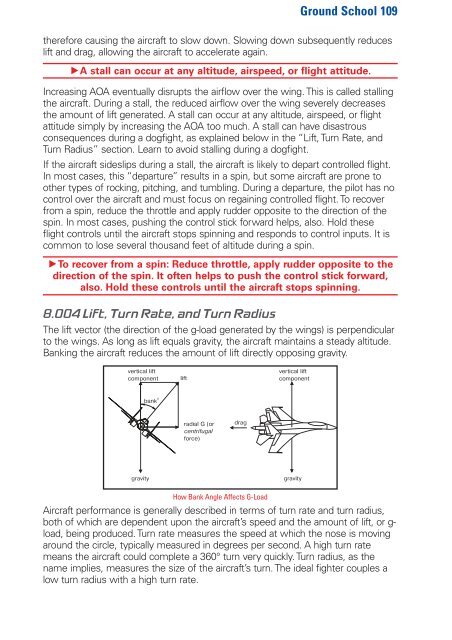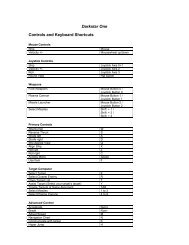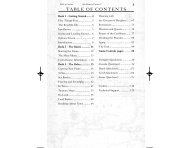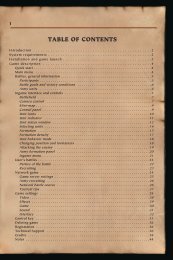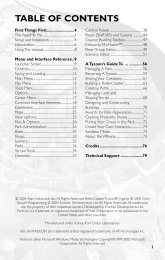Heads-Up Display Modes 35 - Metaboli
Heads-Up Display Modes 35 - Metaboli
Heads-Up Display Modes 35 - Metaboli
You also want an ePaper? Increase the reach of your titles
YUMPU automatically turns print PDFs into web optimized ePapers that Google loves.
Ground School 109<br />
therefore causing the aircraft to slow down. Slowing down subsequently reduces<br />
lift and drag, allowing the aircraft to accelerate again.<br />
hA stall can occur at any altitude, airspeed, or flight attitude.<br />
Increasing AOA eventually disrupts the airflow over the wing. This is called stalling<br />
the aircraft. During a stall, the reduced airflow over the wing severely decreases<br />
the amount of lift generated. A stall can occur at any altitude, airspeed, or flight<br />
attitude simply by increasing the AOA too much. A stall can have disastrous<br />
consequences during a dogfight, as explained below in the “Lift, Turn Rate, and<br />
Turn Radius” section. Learn to avoid stalling during a dogfight.<br />
If the aircraft sideslips during a stall, the aircraft is likely to depart controlled flight.<br />
In most cases, this “departure” results in a spin, but some aircraft are prone to<br />
other types of rocking, pitching, and tumbling. During a departure, the pilot has no<br />
control over the aircraft and must focus on regaining controlled flight. To recover<br />
from a spin, reduce the throttle and apply rudder opposite to the direction of the<br />
spin. In most cases, pushing the control stick forward helps, also. Hold these<br />
flight controls until the aircraft stops spinning and responds to control inputs. It is<br />
common to lose several thousand feet of altitude during a spin.<br />
hTo recover from a spin: Reduce throttle, apply rudder opposite to the<br />
direction of the spin. It often helps to push the control stick forward,<br />
also. Hold these controls until the aircraft stops spinning.<br />
8.004 Lift, Turn Rate, and Turn Radius<br />
The lift vector (the direction of the g-load generated by the wings) is perpendicular<br />
to the wings. As long as lift equals gravity, the aircraft maintains a steady altitude.<br />
Banking the aircraft reduces the amount of lift directly opposing gravity.<br />
How Bank Angle Affects G-Load<br />
Aircraft performance is generally described in terms of turn rate and turn radius,<br />
both of which are dependent upon the aircraft’s speed and the amount of lift, or g-<br />
load, being produced. Turn rate measures the speed at which the nose is moving<br />
around the circle, typically measured in degrees per second. A high turn rate<br />
means the aircraft could complete a 360° turn very quickly. Turn radius, as the<br />
name implies, measures the size of the aircraft’s turn. The ideal fighter couples a<br />
low turn radius with a high turn rate.


